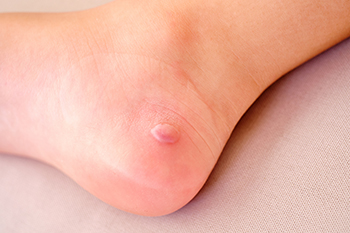
Heel pain in seniors often results from age-related changes in the feet, such as tissue wear, bone thinning, or chronic strain. A common cause of heel pain is plantar fasciitis, which involves inflammation of the thick band of tissue that connects the heel bone to the toes. This condition often leads to sharp pain during the first steps in the morning. Heel spurs, or bony growths beneath the heel, may develop alongside plantar fasciitis and contribute to discomfort. Achilles tendinitis can also cause heel pain, particularly at the back of the ankle, due to overuse or stiffness. Arthritis in the foot joints may lead to inflammation and limited mobility. Seniors are also at greater risk of stress fractures, bursitis, and heel pad syndrome, which results from thinning of the natural cushioning beneath the heel. Tarsal tunnel syndrome or peripheral neuropathy are sources of nerve-related heel pain. A podiatrist can identify the underlying cause of your heel pain. Effective treatment options include custom orthotics, night splints, injections, or surgery. If you are experiencing heel pain, it is suggested that you schedule an appointment with a podiatrist for an exam and a diagnosis to determine the best treatment plan for you.
Many people suffer from bouts of heel pain. For more information, contact one of our podiatrists of Dr. Jeffrey J. Betman & Associates . Our doctors can provide the care you need to keep you pain-free and on your feet.
Causes of Heel Pain
Heel pain is often associated with plantar fasciitis. The plantar fascia is a band of tissues that extends along the bottom of the foot. A rip or tear in this ligament can cause inflammation of the tissue.
Achilles tendonitis is another cause of heel pain. Inflammation of the Achilles tendon will cause pain from fractures and muscle tearing. Lack of flexibility is also another symptom.
Heel spurs are another cause of pain. When the tissues of the plantar fascia undergo a great deal of stress, it can lead to ligament separation from the heel bone, causing heel spurs.
Why Might Heel Pain Occur?
- Wearing ill-fitting shoes
- Wearing non-supportive shoes
- Weight change
- Excessive running
Treatments
Heel pain should be treated as soon as possible for immediate results. Keeping your feet in a stress-free environment will help. If you suffer from Achilles tendonitis or plantar fasciitis, applying ice will reduce the swelling. Stretching before an exercise like running will help the muscles. Using all these tips will help make heel pain a condition of the past.
If you have any questions please contact our offices located in Northwest Chicago, Southwest Chicago, and Wicker Park, Chicago, IL . We offer the newest diagnostic and treatment technologies for all your foot and ankle needs.

Running places significant stress on the feet and toes, making them prone to injury, especially over long distances or running downhill. One common issue is runner’s toe, medically known as a subungual hematoma, which develops when the toenail repeatedly strikes the inside of your shoe. This can lead to bleeding beneath the nail, resulting in changes in nail color, pain, and sometimes nail loss. Poorly fitting running shoes, tight socks, and heat-induced foot swelling can increase the risk. The big toe is most often affected, but the second through fifth toes may also suffer damage from shoe pressure or toe-on-toe friction. In some cases, the nail becomes thick, loose, or may fall off entirely. Repeated trauma may also lead to fungal infection or nail deformity. A podiatrist can assess the extent of the injury and determine if the nail bed or bone has been affected. Treatment includes draining any fluid buildup or in some cases removing the damaged nail. If you have problematic or painful toes that impede your running activities, it is suggested that you schedule an appointment with a podiatrist for an exam and appropriate treatment.
Toe pain can disrupt your daily activities. If you have any concerns, contact one of our podiatrists of Dr. Jeffrey J. Betman & Associates . Our doctors can provide the care you need to keep you pain-free and on your feet.
What Causes Toe Pain?
Most severe toe pain is caused due to a sports injury, trauma from dropping something heavy on the toe, or bumping into something rigid. Other problems can develop over time for various reasons.
Toe pain can be caused by one or more ailments. The most common include:
- Trauma
- Sports injury
- Wearing shoes that are too tight
- Arthritis
- Gout
- Corns and calluses
- Hammertoe
- Bunions
- Blisters
- Ingrown toenails
- Sprains
- Fractures (broken bones)
- Dislocations
When to See a Podiatrist
- Severe pain
- Persistent pain that lasts more than a week
- Signs of infection
- Continued swelling
- Pain that prevents walking
Diagnosis
In many cases the cause of toe pain is obvious, but in others, a podiatrist may want to use more advanced methods to determine the problem. These can range from simple visual inspections and sensation tests to X-rays and MRI scans. Prior medical history, family medical history, and any recent physical traumatic events will all be taken into consideration for a proper diagnosis.
Treatment
Treatments for toe pain and injuries vary and may include shoe inserts, padding, taping, medicines, injections, and in some cases, surgery. If you believe that you have broken a toe, please see a podiatrist as soon as possible.
If you have any questions please feel free to contact our offices located in Northwest Chicago, Southwest Chicago, and Wicker Park, Chicago, IL . We offer the newest diagnostic tools and technology to treat your foot and ankle needs.

Blisters are fluid-filled sacs that form on the skin due to friction, heat, or cold. They commonly develop on the feet as the result of running, wearing ill-fitting shoes, or exposure to extreme temperatures. Blisters caused by friction typically appear as raised, clear bubbles of fluid on the skin, while those caused by heat or cold may be accompanied by redness, swelling, or pain. Symptoms include a painful, tender area where the skin has been damaged. Blisters from heat can occur from burns, while cold blisters may form due to frostbite or prolonged exposure to cold surfaces. The pain can range from mild to intense, especially when pressure is applied. A podiatrist can help by providing proper treatment, such as draining the blister, if necessary, dressing it to prevent infection, and advising on how to avoid future blisters. They can also offer guidance on selecting the right footwear. If you have painful blisters on the feet, it is suggested that you schedule an appointment with a podiatrist.
Blisters may appear as a single bubble or in a cluster. They can cause a lot of pain and may be filled with pus, blood, or watery serum. If your feet are hurting, contact one of our podiatrists of Dr. Jeffrey J. Betman & Associates . Our doctors can provide the care you need to keep you pain-free and on your feet.
Foot Blisters
Foot blisters are often the result of friction. This happens due to the constant rubbing from shoes, which can lead to pain.
What Are Foot Blisters?
A foot blister is a small fluid-filled pocket that forms on the upper-most layer of the skin. Blisters are filled with clear fluid and can lead to blood drainage or pus if the area becomes infected.
Symptoms
(Blister symptoms may vary depending on what is causing them)
- Bubble of skin filled with fluid
- Redness
- Moderate to severe pain
- Itching
Prevention & Treatment
In order to prevent blisters, you should be sure to wear comfortable shoes with socks that cushion your feet and absorb sweat. Breaking a blister open may increase your chances of developing an infection. However, if your blister breaks, you should wash the area with soap and water immediately and then apply a bandage to the affected area. If your blisters cause severe pain it is important that you call your podiatrist right away.
If you have any questions, please feel free to contact our offices located in Northwest Chicago, Southwest Chicago, and Wicker Park, Chicago, IL . We offer the newest diagnostic and treatment technologies for all your foot care needs.

